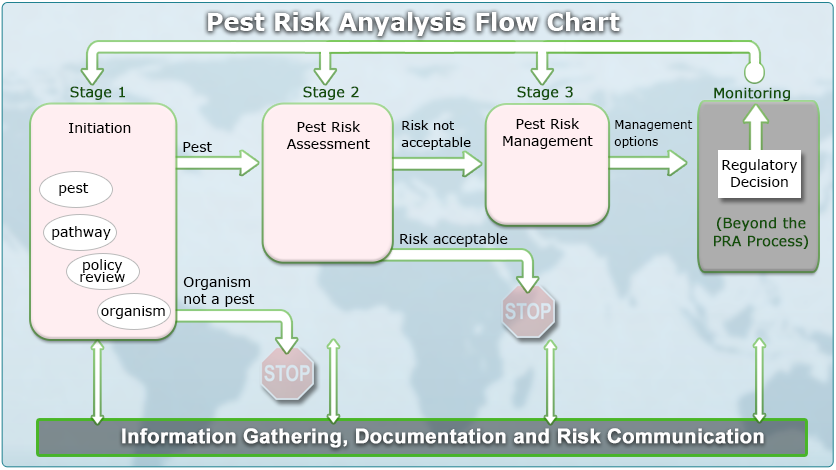Lesson 1: Basic Concepts in Risk Communication
Topic 2: Risk Communication and Plant Protection
This topic discusses risk communication for plant protection. It covers the guidance provided by the IPPC and SPS Agreement on the meaning of risk communication, who the audience for communication is, and why we communicate risk.
Objectives:
- Define risk communication within the context of Pest Risk Analysis, using ISPM 2 as a reference
- Describe the purposes of communicating risk
Risk Communication and Plant Protection
Often, plant protection officials do not focus on risk communication. Instead, they concentrate on risk assessment and risk management. For example, at the time of this writing, the term risk communication is not included in the IPPC’s “ISPM 5 – Glossary of Phytosanitary Terms”. Also, no international standards clearly describe how or when to use risk communication. The IPPC’s “ISPM 2 – Framework for Pest Risk Analysis” defines pest risk analysis as a technical tool used for identifying appropriate phytosanitary measures. The standards note that the process consists of three stages: initiation, risk assessment, and risk management. Risk communication is not defined as a distinct step in pest risk analysis. However, ISPM 2 states that risk communication is an issue common to all pest risk analysis stages. It indicates that communication should occur continually throughout the development of a pest risk analysis.

and the Food and Agriculture Organization of the United Nations, Rome. 432 pp.
As you learned earlier, ISPM 5 defines pest risk assessment as “the evaluation of the probability of the introduction and spread of a pest and the magnitude of the associated potential economic consequences”. ISPM 5 defines pest risk management as “the evaluation and selection of options to reduce the risk of introduction and spread of a pest”. ISPM 2 states that risk communication is an interactive process, allowing exchange of information between the National Plant Protection Organization (NPPO) and stakeholders. Furthermore, risk communication information does not flow one-way nor does it require making stakeholders understand the entire risk situation. Instead, risk communication is meant to reconcile the views of scientists, stakeholders, politicians, and other customers in order to:
- achieve a common understanding of the pest risks
- develop credible pest risk management options
- develop credible, consistent regulations and policies to address pest risks
- promote awareness of the phytosanitary issues under consideration.
Thus, pest risk analysis (PRA) should involve the constant exchange of information and opinions about phytosanitary risk(s) among all stakeholders including: risk analysts, risk managers, policy makers, trading partners, industry, and other interested parties. Ideally, this exchange would take place throughout the entire PRA, from initiation through risk assessment, and ending with risk management. In reality, many NPPOs can face institutional and cultural constraints that make this level of communication impossible. For additional information on constraints to risk communication, see Topic 4 of this Lesson.
ISPM 2 suggests that at the end of pest risk analysis (PRA), all evidence supporting the assessment, the mitigations, and the uncertainties should be communicated to stakeholders and other interested parties as appropriate. The interested parties referred to by ISPM 2 include Regional Plant Protection Organizations (RPPOs), NPPOs, and other contracting parties. Because of this guidance, the document that is developed during the process of PRA can be considered a risk communication document. The benefits of effective risk communication identified by the IPPC include:
- ensuring that outcomes, significance, and limitations of PRA are clearly understood by all stakeholders
- ensuring that all relevant information is included in the PRA
- minimizing objections to risk management decisions by stakeholders
Many articles in the text of the IPPC highlight the importance of sharing information regarding issues of plant health such as: regulated pests, phytosanitary requirements, restrictions, and prohibitions. This information sharing should happen both within the country’s own territory (Article IV.3) and with other contracting parties (Article VII.2). This sharing of information within and between countries can achieve some of the objectives of risk communication as outlined in ISPM 2.
Furthermore, the obligations outlined in the SPS Agreement increase the transparency of sanitary and phytosanitary measures. From Module 1, we know that countries must establish SPS measures on the basis of an appropriate assessment of risks. Countries should communicate: what factors they considered, which assessment procedures they used, and what level of risk they determined to be acceptable. The SPS Agreement indicates that Governments are required to communicate to other countries any new or changed sanitary and phytosanitary requirements that affect trade. Additionally, each country must set up offices to respond to requests for more information on new or existing measures. They also must open to scrutiny the methods of how they apply their regulations for food safety and animal and plant health.
The communication of information among the WTO’s member governments provides a better basis for national standards. This increased transparency and (risk) communication protects the interests of consumers and trading partners from hidden protectionism through unnecessary technical requirements. A committee within the WTO acts as an information exchange forum (two-way communication) on all aspects related to implementation of the SPS Agreement. The SPS Committee reviews compliance with the agreement, discusses matters with potential trade impacts, and maintains close co-operation with the appropriate technical organizations. In a trade dispute regarding a sanitary or phytosanitary measure, the normal WTO dispute settlement procedures are used, and advice from appropriate scientific experts can be sought.
Effective plant health risk communication is vital in the development of risk management options and regulations and policies to deal with pest risks. Even though effective communication results in valuable understanding of pest risks, it has not been given the same consideration and emphasis as the more technical components of risk analysis: risk assessment and risk management.
To continue, select Topic 3 from the Topics menu above or click here.